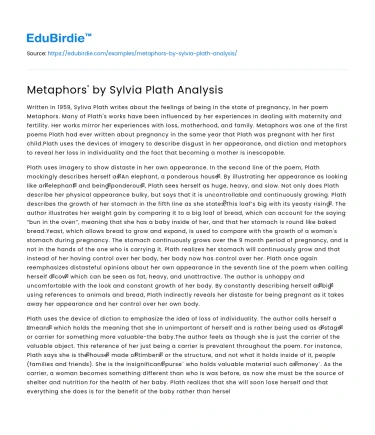Written in 1959, Syliva Plath writes about the feelings of being in the state of pregnancy, in her poem Metaphors. Many of Plath's works have been influenced by her experiences in dealing with maternity and fertility. Her works mirror her experiences with loss, motherhood, and family. Metaphors was one of the first poems Plath had ever written about pregnancy in the same year that Plath was pregnant with her first child.Plath uses the devices of imagery to describe disgust in her appearance, and diction and metaphors to reveal her loss in individuality and the fact that becoming a mother is inescapable.
Plath uses imagery to show distaste in her own appearance. In the second line of the poem, Plath mockingly describes herself as ̈An elephant, a ponderous house ̈. By illustrating her appearance as looking like an ̈elephant ̈ and being ̈ponderous ̈, Plath sees herself as huge, heavy, and slow. Not only does Plath describe her physical appearance bulky, but says that it is uncontrollable and continuously growing. Plath describes the growth of her stomach in the fifth line as she states,̈This loaf’s big with its yeasty rising ̈. The author illustrates her weight gain by comparing it to a big loaf of bread, which can account for the saying “bun in the oven”, meaning that she has a baby inside of her, and that her stomach is round like baked bread.Yeast, which allows bread to grow and expand, is used to compare with the growth of a woman's stomach during pregnancy. The stomach continuously grows over the 9 month period of pregnancy, and is not in the hands of the one who is carrying it. Plath realizes her stomach will continuously grow and that instead of her having control over her body, her body now has control over her. Plath once again reemphasizes distasteful opinions about her own appearance in the seventh line of the poem when calling herself a ̈cow ̈ which can be seen as fat, heavy, and unattractive. The author is unhappy and uncomfortable with the look and constant growth of her body. By constantly describing herself as ̈big ̈ using references to animals and bread, Plath indirectly reveals her distaste for being pregnant as it takes away her appearance and her control over her own body.
Save your time!
We can take care of your essay
- Proper editing and formatting
- Free revision, title page, and bibliography
- Flexible prices and money-back guarantee
Plath uses the device of diction to emphasize the idea of loss of individuality. The author calls herself a ̈means ̈ which holds the meaning that she in unimportant of herself and is rather being used as a ̈stage ̈ or carrier for something more valuable-the baby.The author feels as though she is just the carrier of the valuable object. This reference of her just being a carrier is prevalent throughout the poem. For instance, Plath says she is the ̈house ̈ made of ̈timbers ̈ or the structure, and not what it holds inside of it, people (families and friends). She is the insignificant ̈purse¨ who holds valuable material such as ̈money¨. As the carrier, a woman becomes something different than who is was before, as now she must be the source of shelter and nutrition for the health of her baby. Plath realizes that she will soon lose herself and that everything she does is for the benefit of the baby rather than herself.
Plath uses metaphors to show her loss of individuality and choice. In the last line of the poem, Plath states ̈Boarded the train there's no getting off ̈. Here, Plath also recognizes that she has no choice but to carry on the pregnancy whether she wanted the baby or not. She knows that motherhood is long-term and that she can't go back to being her former-pregnant self. By saying ̈ there's no getting off ̈, plath implies that there is no chance of this change not happening, especially during the time period. During the late 1950s, when this poem was written, Plath would not been able to get an abortion because theu were were illegal, but also risky. In the 1950s and 1960s, the number of illegal abortions ¨ranged from 200,000 to 1.2 million per year¨. Although antiobiotics and effective medical treatments were introduced, ¨illegal abortions still accounted for 17% of all deaths attributed to pregnancy and childbirth¨. These numbers were just those being reported, many women hid their abortions and would not speak about them publicly. In this quote, Plath could also be talking about the sacrifices that mothers such as she would have to make, such as her career. During this century, women were stereotypically seen as people who should become housewives and mothers rather than receive educations and jobs like their male counterparts. This was similar to Sylvia Plath ́s case, who was married by the age of 24 and was ̈forced to leave it (academic life) behind ̈ when she became a mother. In the last line of the poem, Plath reveals the hurt and sacrifice in leaving behind a life once dedicated to herself and career, to a life dedicated to another.
Pregnancy as well as motherhood brings substantial changes to a woman's life. A woman's physical body, mental health, and her life can change forever. Women have to deal with physical body changes such as increased weight, they have to deal with continuous pain, and even postpartum depression. Many women today, just like Sylvia Plath, must sacrifice their work, their time and energy, to take care of a child. Still to this day in the United States, several state governments have prohibted abortion, preventing women from making their own decisions about their bodies. Sylvia Plath spoke up for those women who were not able to speak for themselves. She spoke up about issues neglected and hidden by society.






 Stuck on your essay?
Stuck on your essay?

